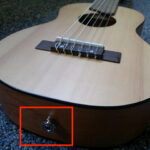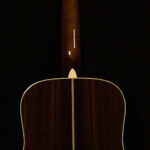Last updated: [Current Date]
Are you intrigued by offset guitars and the iconic Jazzmaster shape but hesitant about the price tag of a Fender? The Squier Classic Vibe ’60s Jazzmaster might be the answer. This review dives deep into this popular model, exploring its features, playability, sound, and overall value as a Squire Guitar option. We’ll help you decide if this guitar is the right fit for your musical journey.
At guitarplayers.net, we pride ourselves on unbiased and thorough reviews. Like you, we’re passionate about guitars. We purchased this Squier Classic Vibe ’60s Jazzmaster with our own funds to bring you a genuine player’s perspective. We have spent considerable time putting this squire guitar through its paces, comparing it to higher-end models and evaluating its strengths and weaknesses. Our goal is to provide you with the information you need to make an informed decision, whether you’re a seasoned player or just starting your guitar journey.
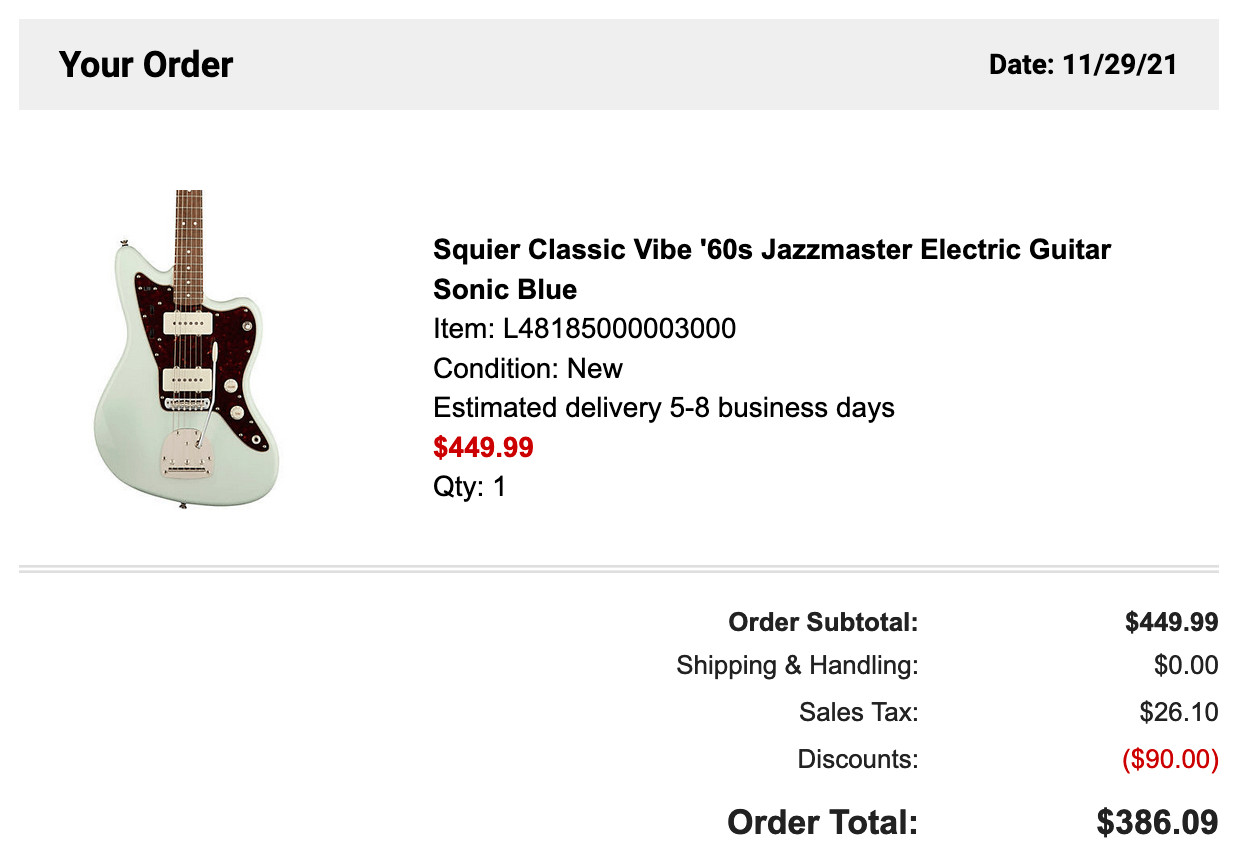 Receipt for Squier Classic Vibe 60s Jazzmaster purchase
Receipt for Squier Classic Vibe 60s Jazzmaster purchase
We’ve logged over 40 hours playing this Sonic Blue beauty, meticulously analyzing every aspect to determine if this squire guitar lives up to the hype and whether it deserves a place in your collection. Let’s explore what makes the Squier Classic Vibe ’60s Jazzmaster a compelling choice for guitarists seeking that classic offset vibe without breaking the bank.
Squier Classic Vibe ’60s Jazzmaster: Quick Verdict
7.6 out of 10
Around $450 (New) – Price may vary
The Squier Classic Vibe ’60s Jazzmaster offers incredible value for money. It captures the vintage aesthetics and unique sound of a ’60s Jazzmaster at an accessible price point. While it may require some initial setup and might benefit from minor upgrades for discerning players, it’s a fantastic squire guitar that delivers a fun playing experience and inspiring tones.
Pros:
- Eye-catching vintage looks
- Authentic Jazzmaster sound
- Inspiring and fun to play
- Exceptional value for a squire guitar
Cons:
- Factory setup may need adjustment
- Single-coil pickups can be noisy
- Some players might consider upgrades for optimal performance
Is this Squier Guitar for You?
Check Used Prices
Check New Prices
Video Review: Squier Classic Vibe Jazzmaster In Action
Want to see and hear this squire guitar in action? We’ve created a detailed video review showcasing the Squier Classic Vibe ’60s Jazzmaster. Our video review offers a comprehensive look at its features, sound demos, and our hands-on experience.
[Link to Video Review Part 1 (Sound Demo Included)]
[Link to Video Review Part 2 (Deeper Dive)]
[Link to 45-Second Quick Review]
For those short on time, our Part 1 video is essential viewing, featuring sound demonstrations that truly capture the essence of this squire guitar. Part 2 delves deeper into the nuances and finer points of the Classic Vibe Jazzmaster. And if you’re really pressed for time, our 45-second quick review provides a rapid overview.
Delving into the Squier Classic Vibe ’60s Jazzmaster Specs
The Squier Classic Vibe ’60s Jazzmaster is designed to faithfully replicate the vibe and specifications of a 1960s Fender Jazzmaster. As a squire guitar, it aims to provide an authentic experience at a more accessible price. Key features include 21 frets, a bone nut (some models may vary, always check specifications), vintage-style tuners, and Fender-designed single-coil pickups – crucial for that signature Jazzmaster tone. It also boasts the iconic Jazzmaster tremolo system and, importantly, the distinct Rhythm and Lead circuits that define this model’s versatility.
 Jazzmaster Rhythm & Lead Circuit Switch
Jazzmaster Rhythm & Lead Circuit Switch
Understanding the Rhythm & Lead Circuits on this Squire Guitar
The Rhythm and Lead circuits are a defining feature of the Jazzmaster, and the Squier Classic Vibe ’60s Jazzmaster accurately incorporates them. In simple terms:
- Rhythm Circuit (Upper Switch Position): Engages the neck pickup with a preset darker tone and volume, bypassing the standard pickup selector and lower controls. The two thumbwheel controls adjust volume and tone specifically for the rhythm circuit. This is ideal for warmer, mellower tones, perfect for rhythm playing.
- Lead Circuit (Lower Switch Position): Activates the traditional pickup selector switch and lower volume/tone controls. This circuit allows for full control over pickup selection (neck, both, bridge) and tone shaping, offering brighter and more versatile sounds for lead playing and general use.
For a more detailed explanation and audio examples of these circuits in action on this squire guitar, be sure to check out our video review (Part 1).
Initial Impressions: Unboxing the Squier Jazzmaster
Excitement was high when we received this Squier Classic Vibe ’60s Jazzmaster. However, the out-of-box experience was a mixed bag. While the guitar looked stunning in Sonic Blue, closer inspection revealed some minor issues.
 Classic Vibe Jazzmaster pickups & body photo
Classic Vibe Jazzmaster pickups & body photo
We noticed some glue residue and minor dirt on the fretboard. There were also a couple of small, cosmetic chips in the fretboard edge (not affecting playability) and a slight blemish in the finish. While these weren’t major flaws, they were unexpected on a new instrument, especially considering the price point of squire guitars in this range.
Despite these initial disappointments, the guitar felt good in hand, and its visual appeal was undeniable. We recognized that with a bit of cleanup and setup, this squire guitar had the potential to be a fantastic instrument.
We contacted the retailer, who were understanding and offered a partial refund to compensate for the time needed to address these minor issues. This allowed us to keep the guitar and invest a little time into making it perfect.
Potential Drawbacks of the Squier Classic Vibe Jazzmaster
While the Squier Classic Vibe ’60s Jazzmaster offers tremendous value, it’s important to be aware of a couple of common points that players consider:
-
Single-Coil Noise: Like many guitars with single-coil pickups, Jazzmasters are inherently susceptible to noise, particularly hum. This is a characteristic of the design and not necessarily a flaw of this squire guitar specifically. While some players might find it bothersome, many consider it part of the vintage charm and character of single-coil instruments. Noise gates can effectively minimize hum if needed.
-
Upgrade Considerations: The Squier Classic Vibe series is designed to be excellent right out of the box. However, some players, especially those seeking professional-level performance, might consider certain upgrades. Common upgrades for Jazzmasters, in general (not just squire guitars), often include the bridge and tremolo system for enhanced stability and smoother operation. However, for most players, especially at this price point, these upgrades are far from essential.
In our case, the only “upgrade” we deemed beneficial was a neck shim, costing around $20. This minor adjustment improved the guitar’s setup and playability to our preference. We believe that the Squier Classic Vibe ’60s Jazzmaster is perfectly gig-worthy and enjoyable without mandatory upgrades.
The Allure of the Squier Classic Vibe Jazzmaster: The Pros
If you’re drawn to Jazzmasters, you likely already appreciate their inherent appeal. The Squier Classic Vibe ’60s Jazzmaster successfully captures these key advantages:
-
Stunning Aesthetics: The vintage-inspired design, finish options like Sonic Blue, and overall look of this squire guitar are undeniably attractive. It captures the cool, offset vibe that makes Jazzmasters so visually appealing.
-
Inspiring Sound: The Fender-designed pickups deliver authentic Jazzmaster tones. These pickups are known for their unique blend of clarity, warmth, and a slightly scooped midrange. They excel in clean and driven tones, making this squire guitar versatile for genres like indie, alternative, surf rock, and more.
-
Fun and Engaging Playability: The comfortable neck profile and overall feel of the Squier Classic Vibe ’60s Jazzmaster make it a joy to play. It’s a guitar that inspires you to pick it up and explore new musical ideas.
For many guitarists, these core elements – looks, sound, and feel – are paramount. The Squier Classic Vibe ’60s Jazzmaster delivers on all fronts, making it an exceptionally appealing squire guitar option.
Setting Up Your Squier Jazzmaster for Optimal Playability
As mentioned earlier, our review unit required some setup attention out of the box, primarily cleaning. While the issues were cosmetic, proper setup is crucial for any guitar to play its best.
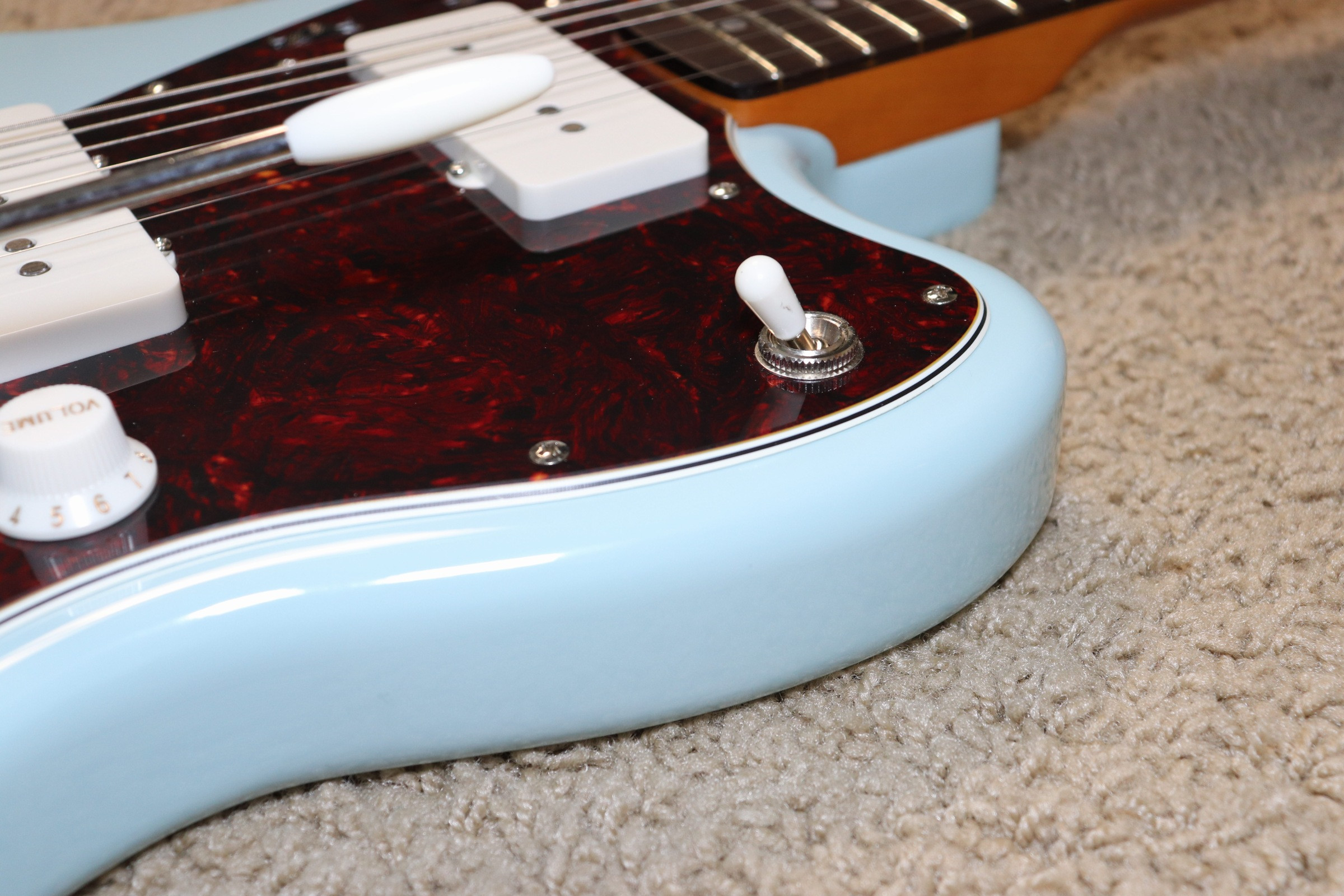 Classic Vibe Jazzmaster lower bout photo
Classic Vibe Jazzmaster lower bout photo
Here’s a summary of the setup steps we took:
- Fret Cleaning: We carefully removed glue residue from the frets using a razor blade. (Approximately 30 minutes)
- Fret Polishing: We polished the frets using micromesh polishing cloths for a smooth feel. (Approximately 45 minutes)
- Fretboard Conditioning: We cleaned and conditioned the fretboard with lemon oil to hydrate the wood.
- Neck Shim Installation (Optional but Recommended): We installed a 0.5-degree neck shim to adjust the neck angle. This improved the string break angle over the bridge, contributing to better sustain and potentially reducing string slippage – a common tweak for Jazzmasters.
- Bridge Height Adjustment: After the shim, we raised the bridge to achieve optimal string height and action.
- Intonation Adjustment: Finally, we set the guitar’s intonation for accurate tuning across the fretboard.
While some of these steps might seem advanced, basic guitar setup tasks like cleaning, string changes, and intonation are valuable skills for any guitarist. Numerous online resources and videos, including our own guide on how to set guitar intonation, can assist you.
The Sound of a Squier Jazzmaster: Tonal Versatility
The Squier Classic Vibe ’60s Jazzmaster truly shines in the sound department. The Fender-designed pickups capture the distinctive Jazzmaster voice – a sound that’s both articulate and full-bodied.
[Short Audio Demo Link – if available in original content]
Jazzmaster pickups offer a unique sonic palette. They can be thick and warm, even slightly “muddy” in a pleasing vintage way, yet also clear and articulate depending on your playing dynamics and tone settings. They pair exceptionally well with fuzz pedals and offer a beautiful clean tone that’s distinct from Stratocaster or Telecaster pickups. This squire guitar is capable of a wide range of tones, suitable for various musical styles.
Potential Upgrades: Personalizing Your Squire Guitar
While we believe the Squier Classic Vibe ’60s Jazzmaster is excellent as is, some players enjoy personalizing their instruments. Here are a few common upgrade considerations, though none are strictly necessary:
- Tremolo and Bridge: Some players upgrade the tremolo and bridge for potentially smoother operation and enhanced tuning stability, particularly with more aggressive tremolo use. However, we found the stock tremolo to be functional and stable for typical Jazzmaster playing styles. A simple trick like using plumber’s tape on the tremolo arm or firmly pressing it into the socket can eliminate any rattling, as we demonstrated in our video review.
- Tuners: Locking tuners are a popular upgrade for many guitars, offering faster string changes. While the stock vintage-style tuners on this squire guitar are perfectly functional and tuning stability isn’t an issue, locking tuners can be a convenient personal preference.
- Pickups: While the stock pickups are excellent, pickup swaps are a common way to explore different tonal variations. However, we are very satisfied with the stock pickups and have no immediate plans to replace them.
Squier Classic Vibe 60s Jazzmaster: Photo Gallery
[Image Grid of Squier Classic Vibe Jazzmaster Photos]
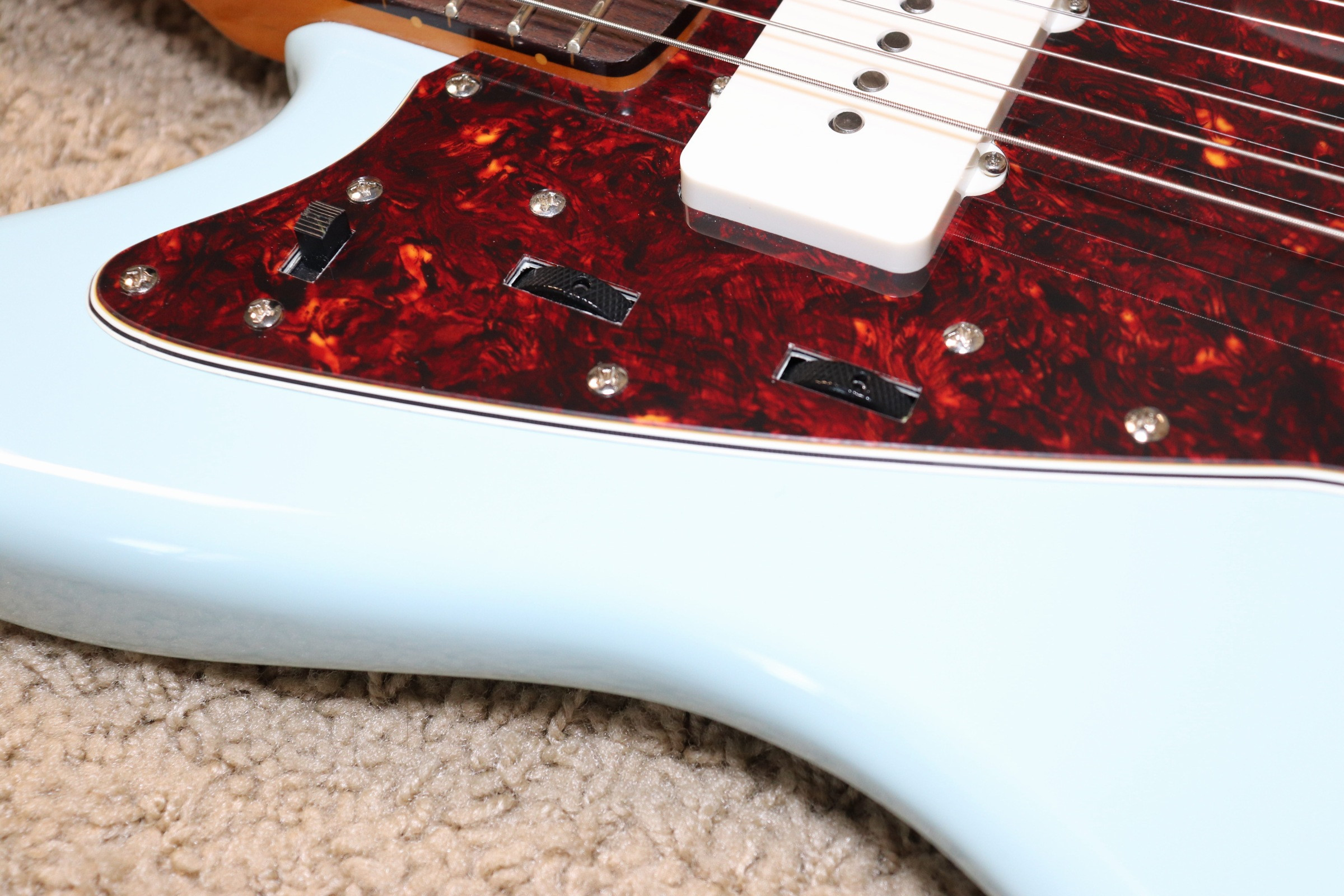 Squier Classic Vibe Jazzmaster full body shot
Squier Classic Vibe Jazzmaster full body shot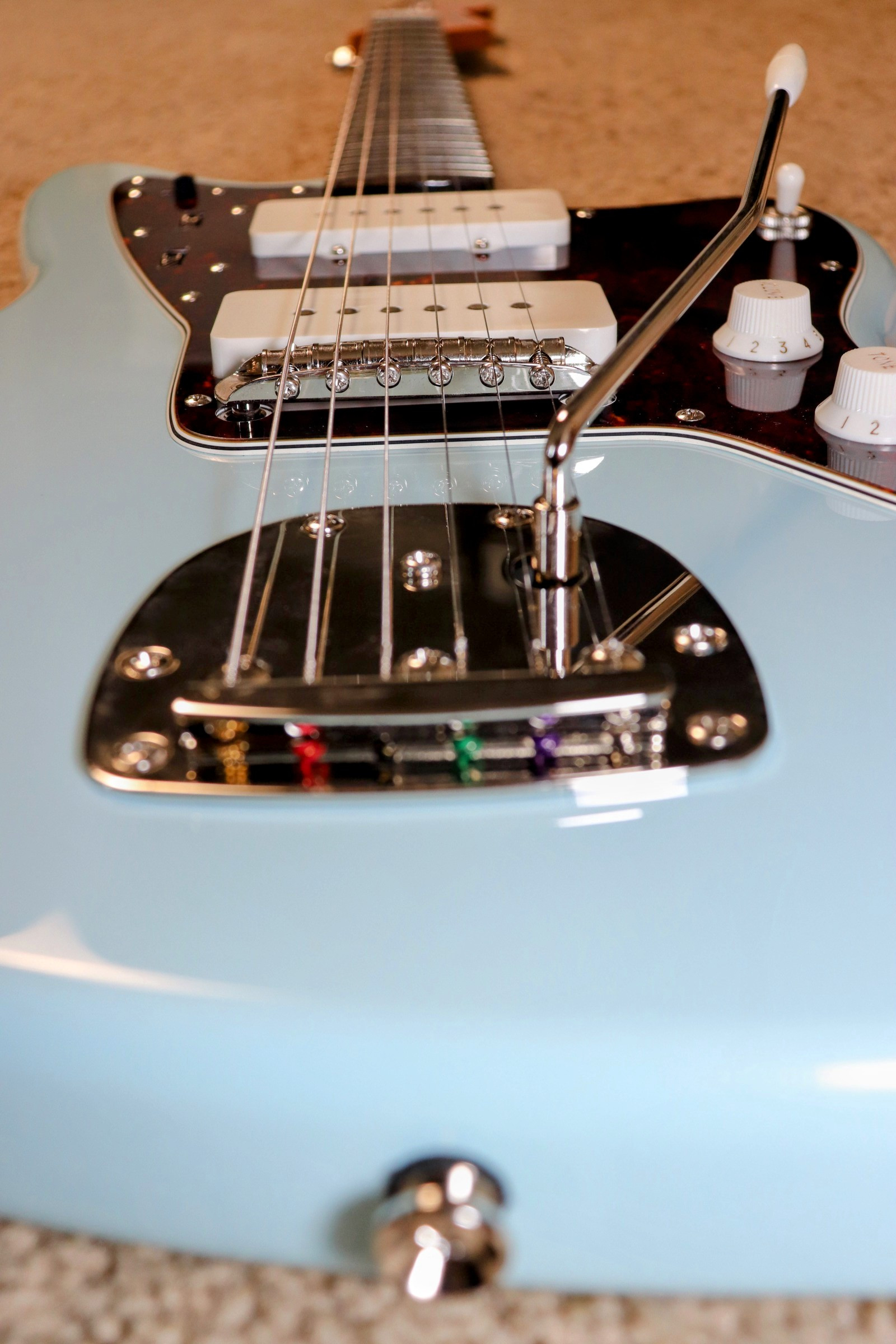 Squier Classic Vibe Jazzmaster headstock detail
Squier Classic Vibe Jazzmaster headstock detail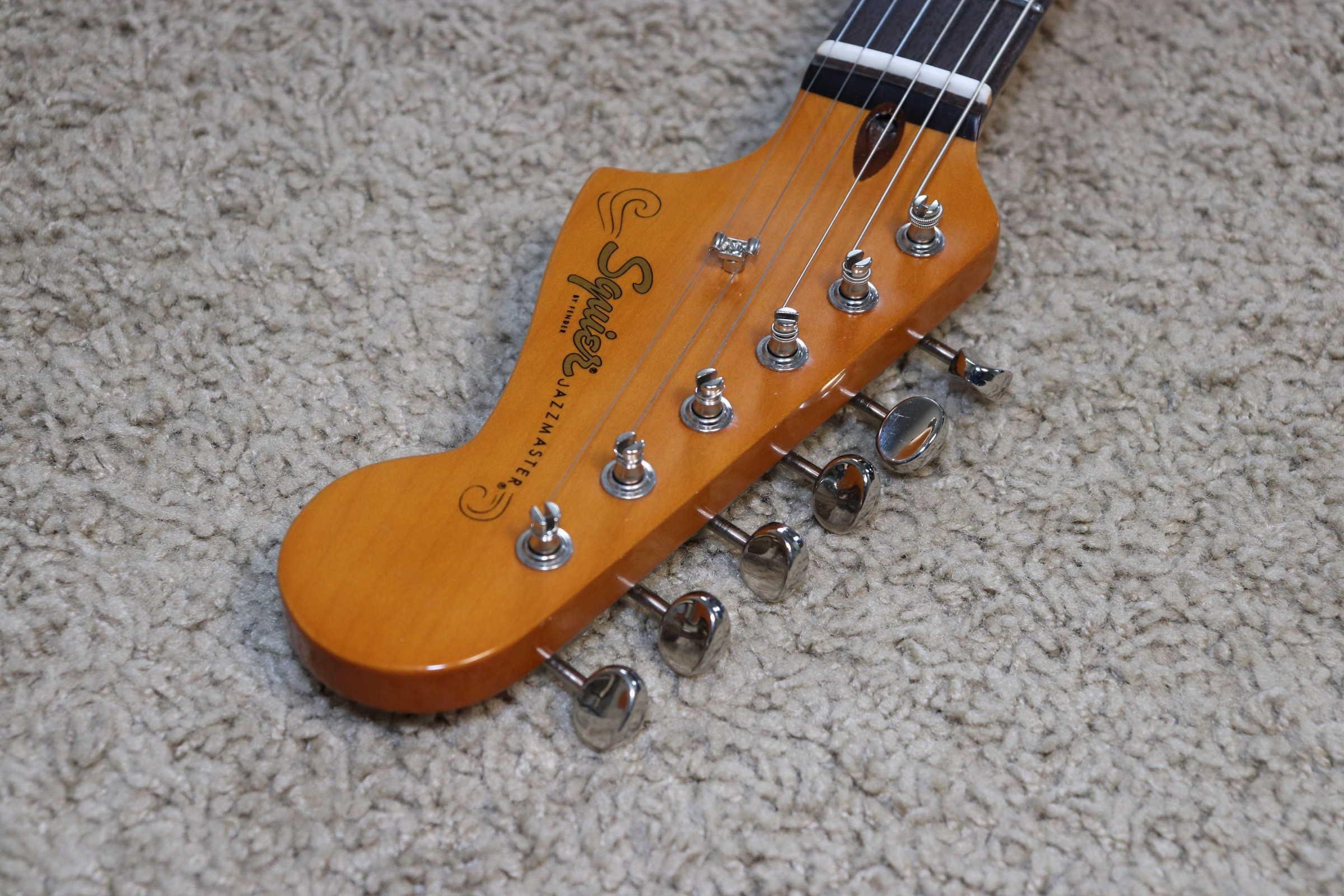 Squier Classic Vibe Jazzmaster body close up
Squier Classic Vibe Jazzmaster body close up Classic Vibe Jazzmaster pickups & body photo
Classic Vibe Jazzmaster pickups & body photo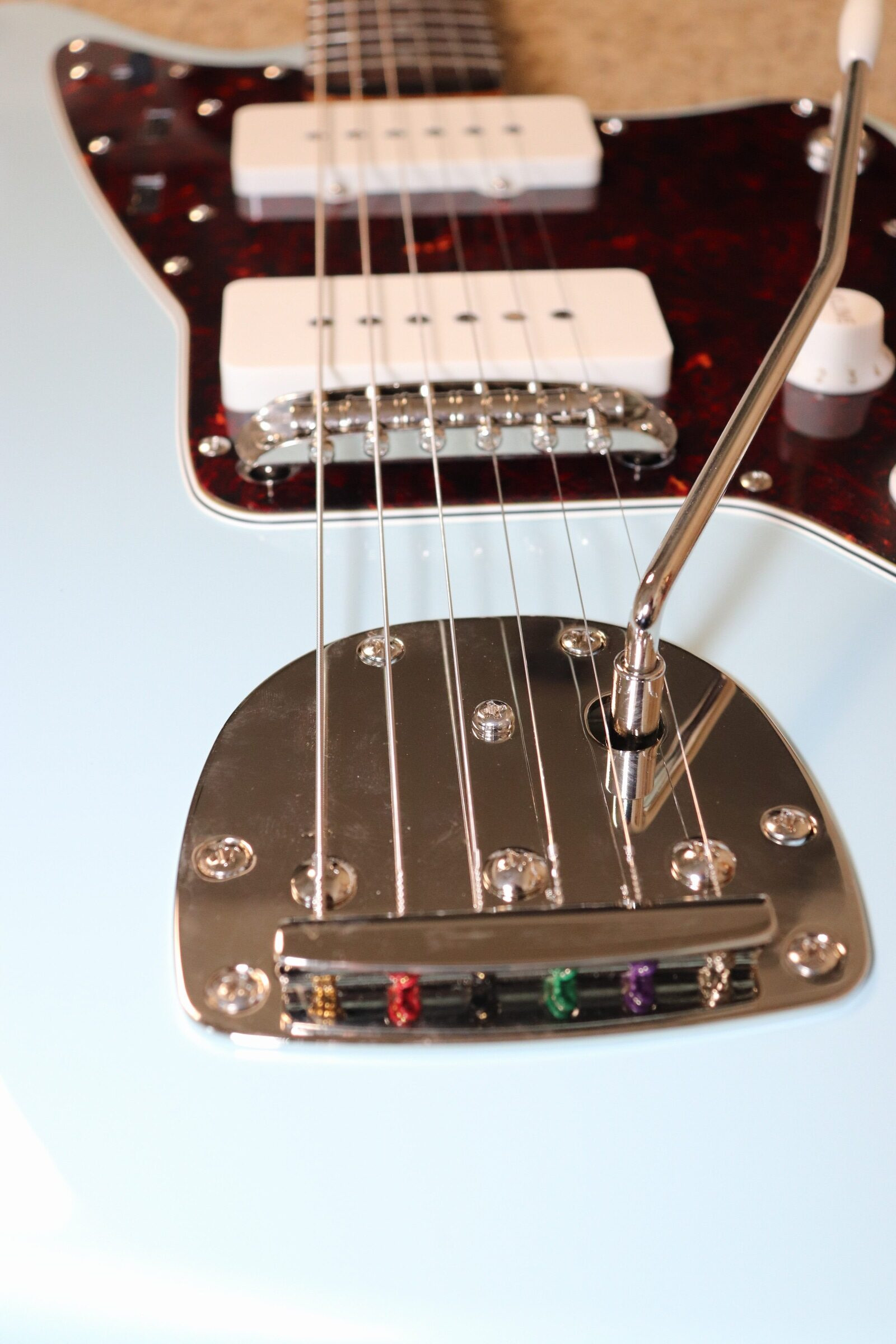 Squier Classic Vibe Jazzmaster fretboard detail
Squier Classic Vibe Jazzmaster fretboard detail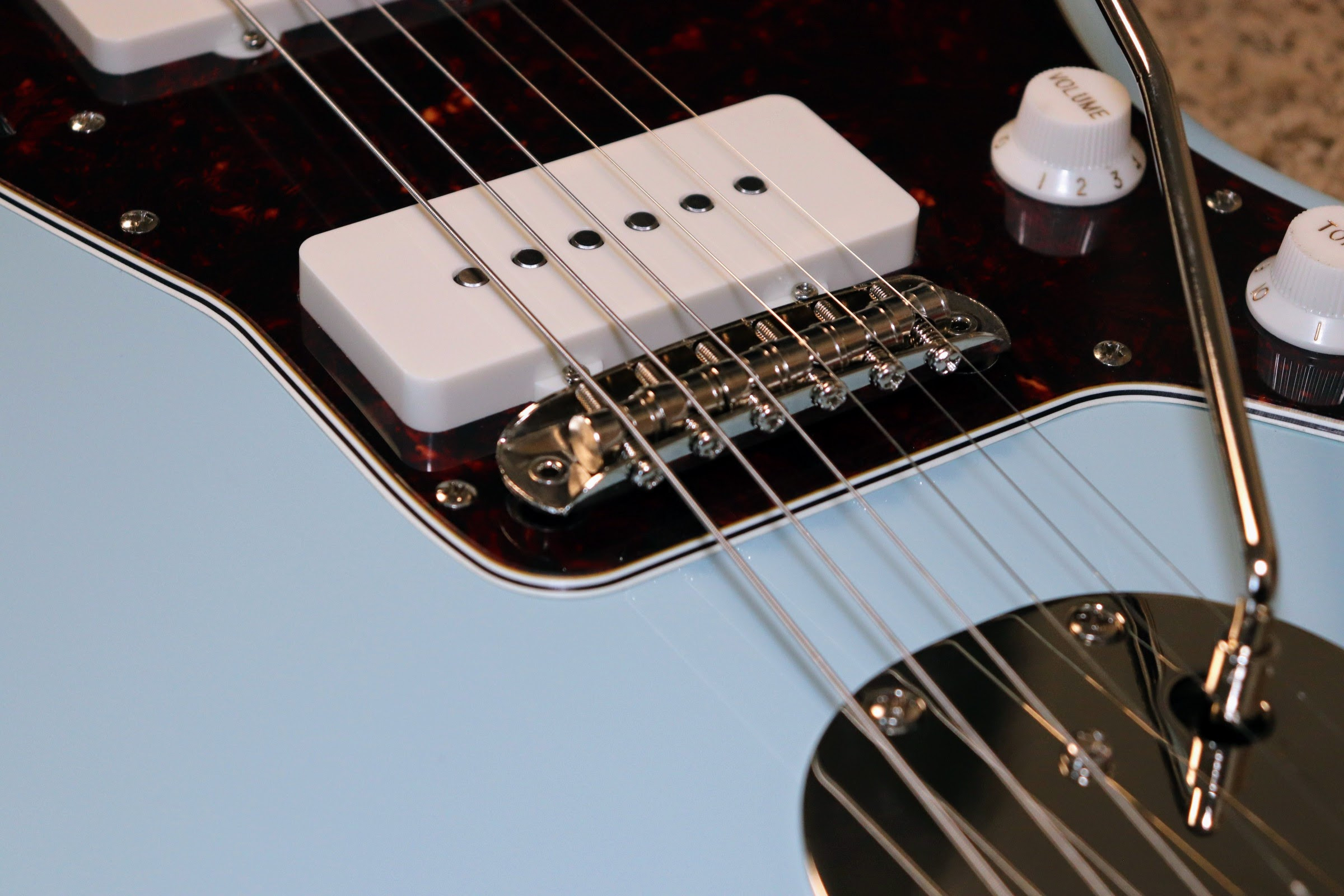 Squier Classic Vibe Jazzmaster controls
Squier Classic Vibe Jazzmaster controls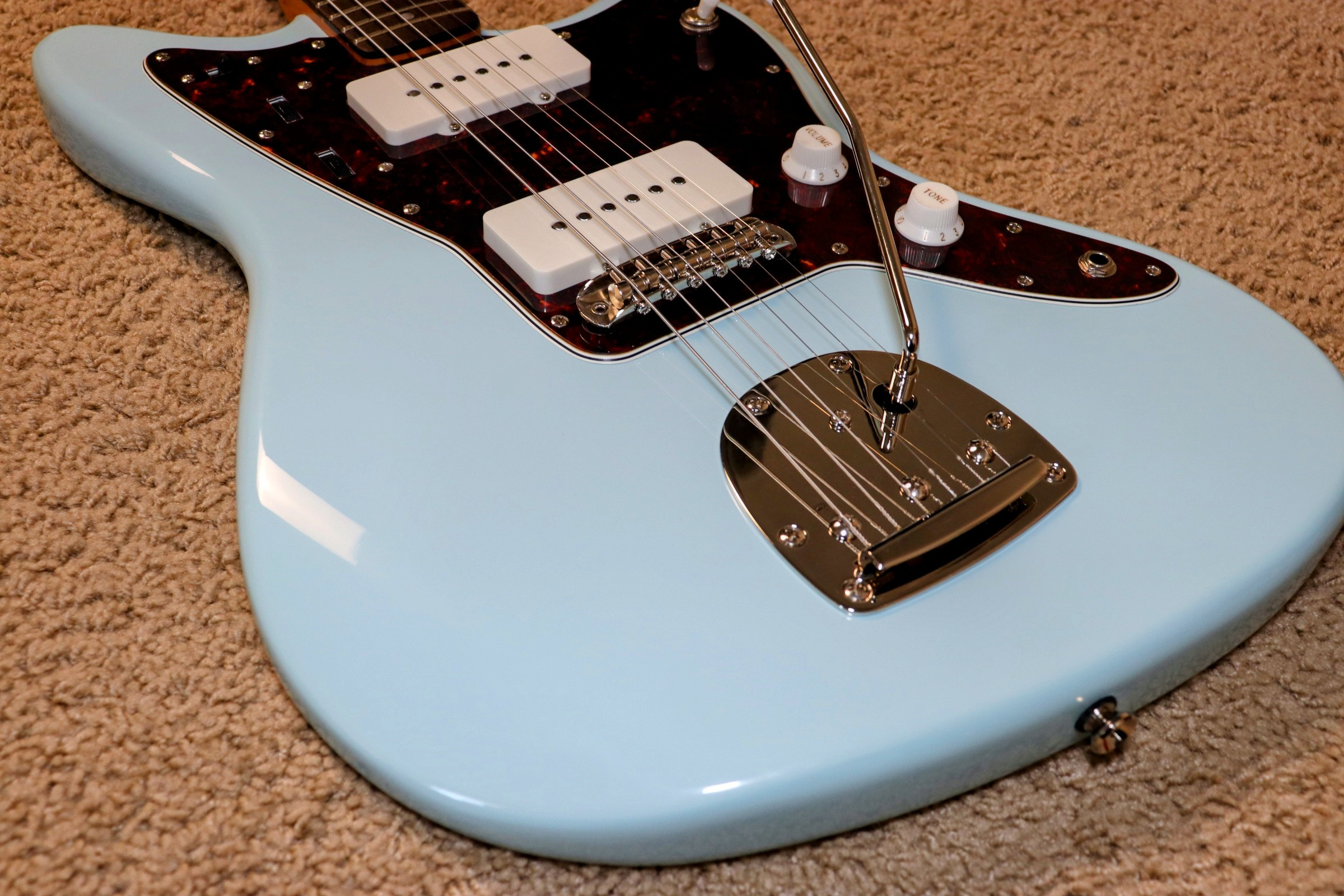 Squier Classic Vibe Jazzmaster body angle
Squier Classic Vibe Jazzmaster body angle
Final Verdict: Should You Buy This Squire Guitar?
If you’re drawn to offset guitars, the unique sound of a Jazzmaster, and genres like shoegaze, indie, or alternative music, and you’re seeking a fantastic value option without spending a fortune on a Fender, the Squier Classic Vibe ’60s Jazzmaster is an excellent choice. It delivers the essential features and vintage charm of its Fender counterpart at a significantly lower price.
Despite our minor out-of-box experience, which may be atypical, we wholeheartedly recommend the Classic Vibe ’60s Jazzmaster. If you can find it for under $400 used, it’s an absolute steal. Even at its new price point around $450, it represents exceptional value for a squire guitar that captures the essence of a classic instrument.
Overall Score: 7.6/10 (Potentially higher with a flawless out-of-box experience)
Do you own a Squier Classic Vibe Jazzmaster or another squire guitar? Share your thoughts and experiences in the comments below! We’d love to hear from you.

